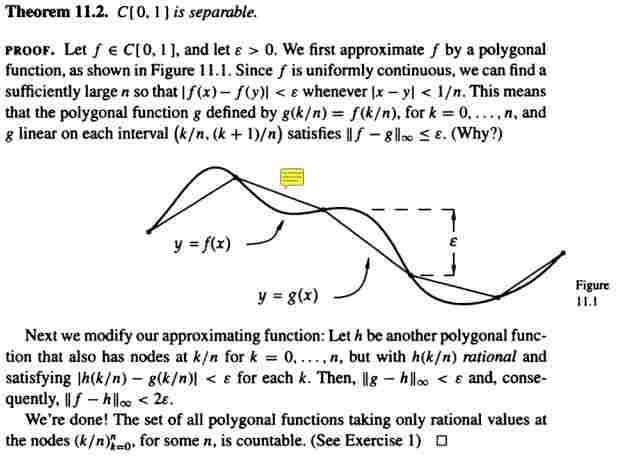Completions using distance functions
Recall is the space of continuous bounded functions . We know that it is complete.
Proposition 165.1.
Let be a metric space. There exists an isometric embedding . is the completion of .
Proof.
Fix . For each , define . is uniformly continuous:
is bounded, too: . Thus, .
Define by . For any ,
So,
At , attains . Thus, , and is an isometry.
Since is complete, the completion of is given by .□
Separable spaces
Recall what a separable space is.
Lemma 165.2.
35d96dThe property of denseness is transitive, that is, If , is dense in , and is dense in , then is dense in .
Proposition 165.3.
74c8abis separable.
Proof.
Let be the set of all sequences in which have finitely many non-zero terms. Let . is countable:
It is clear that is dense in . If we show is dense in , we’ll be done by Lemma 2.
Let . Let be a sequence, with and
Now,
Thus, .□
Exercise 165.4.
- is separable.
- is separable.
Example 165.5.
Define . We will show that is a separable subspace of . Let be as in Proposition 3.
Let , and define as we have previously.
Example 165.6.
is not separable. Consider . For any , . Consider the disjoint uncountable collection of open balls . Since a dense subset of must intersect all open balls of , a countable dense subset doesn’t exist.
Exercise 165.7.
Completion of a separable metric space is separable.
Immediate from Lemma 2.
Exercise 165.8.
If a space is totally bounded, it is separable.
Let be a totally bounded space. For , let be a finite cover of by balls of radius , and define . Take . is countable. is dense in since for any , we have balls such that for all , so the centers of the balls converge to .
[!Exercise]
The space of all non-empty compact subsets of a separable metric space endowed with the Hausdorff metric is separable.
Proposition 165.9.
Let with with , and . Suppose is continuous. Then .
Proof.
It should be clear that. Let . is continuous, so there exists such that implies . Choose such that for all . If , then , so . Thus, .□
Counterexample when : Let , . for all .
Reviewed the Cantor intersection theorem.
